An Artists Review
As a painter using oil and cold wax medium, I am always in the search for tools that create interesting marks and textures. It is important for me to have a range of marks on a piece, to avoid too much similarity as this can lead to a uniform surface that lacks interest. The nature of the medium means painting with CWM is a sculptural experience; building layers, scraping back, glazing, and rebuilding. I have a selection of favorite pottery and kitchen tools but until Isaw Elizabeth Schowachert’s handmade tools none specifically made for using with CWM.
I was thrilled when she got in touch and asked if I would review a selection of her CWM tools. For those readers new to CWM it’s worth stating that most artists lay down paint with a spreader, brayer or palette knife before working into the paint with tools that create textures, or scraping to reveal under-layers of paint. It is possible to use brushes to apply the paint but they need to be very stiff to push the paint around, and in my experience, they clog too easily.
With that in mind, Elizabeth has created a range of texturing and blending tools specifically for using with CWM, many of which can also be used with encaustic. As soon as they arrived and I unpacked them at once I was struck by the quality of the craftsmanship. These are pieces of art in their own right, made with skill, care and attention to detail. It is worth noting here that I am a very messy worker and heavy-handed with my tools. When I am in full creative flow tools go flying and afterward my studio looks as if a class of five-year-olds has been let loose! A flurry of questions immediately came to mind; would they stand up to my way of working? Could I allow myself to use such beautiful things? What could they offer me that my other tools could not? The only way to find out was to use them, abuse them and see for myself!
Elizabeth sent five tools covering a variety of shapes and sizes; long and short, thick and thin, all beautifully made with attention to detail. The first thing that struck me was the scale, the longest is 12″. These are not small delicate tools. They fit in your hand and fill it. This aspect alone conveys solidity and confidence and encourages strong actions, resulting in expressive mark-making. Few brushes are this big and fewer pottery tools.

|
They arrived the day before I taught a two-day workshop. As this was a beginner’s course I didn’t introduce them until the very end of the first day. After directing the students to lay down a thick layer of paint on a few of their paintings I gathered them around and showed them the tools they could use to create textures that we would glaze over the following day. Whilst they delighted in the sculptural nature of the tools, and the quality of the workmanship, they were also reluctant to use them for fear of damaging them. But their initial hesitation didn’t last long! They soon got to work, exploring the wide variety of marks that could be achieved. The buzz in the room was palpable, with lots of ‘wow’s, ‘ooh’s an animated discussion about what tool could make what mark. Once they started it was hard to get them to stop!
 |
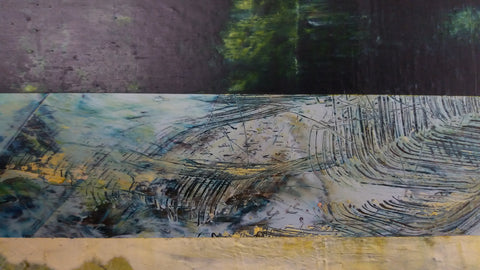
|
Samara used the Leather Wrap “FLAT-HEAD” Cold Wax Fiber Brush
After they had finished for the day I was left with the question of how to clean Elizabeth’s brushes. On her website, she gives cleaning instructions with each tool. It was easier than I expected. I filled a tray with thinner, swished the tools around, and wiped them with a clean cloth, the nature of the fiber ‘bristles’ means they don’t absorb the paint, it just sits on the surface. The bamboo handles have a smooth surface and wipe clean easily. The brush with the leather handle did hold onto some residual paint but I used some solvent on a cloth to wipe it off. The horsehair bristle brush stained a little as any animal bristle brush would. Within minutes they were all as good as new!
Cleaned!
The following day the process of glazing over the marks revealed exciting textures and layers, the students were delighted, and I was keen to try them out myself over the next few weeks, to put them thoroughly through their paces.
The Slant Cold Wax Fiber Brush soon became my favorite, the size is impressive and the physical action of sweeping it across a layer of paint using my whole arm was intensely satisfying. The resultant mark was large and expressive; very different from most marks I make with CWM. It had more in common with the gestural marks from ink on paper.
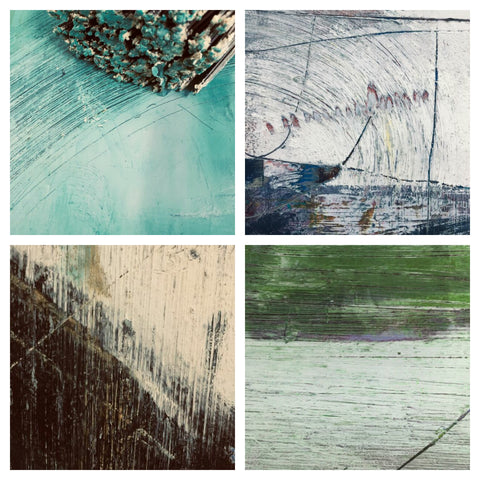
A range of gestural textures created with the Slant Cold Wax Fiber Brush
I concluded that it is the angle of the brush head that is important. Whilst this is similar to bristle its flat head makes for a very different gesture. The head removed a lot of paint leaving deep textural lines that when glazed over remain an integral part of the surface of the painting.

The head of the Slant Fiber brush removes a lot of paint, leaving deep textural lines that reveal the colors beneath. When glazed over the lines remain an integral part of the surface of the painting.
Here I glazed over the dry layer with Indian Yellow.
Leather Wrap “FLAT-HEAD” Cold Wax Fiber is smaller than the slant head brush but a great workhorse for its size! It was my student Samara’s favorite as it gives such a wide variety of marks depending on how it is held and used. It lends itself to swirls and curves, but it’s also good for lines and stippling.
 |
Brushing into a white layer to reveal the darker underlayer. |
 |
Here I used a rather mucky brush to lift off a layer of Paynes Grey in a swirling motion. |
Copper is the main component of the Copper Wire Brush with Bamboo Root Handle. The longest of the group it is a 12″ slender tool with a copper ‘hand’ at the one end. This gives unpredictable marks, scoring into the paint like an ice skating insect! One is encouraged by the tool to twist and turn it on your hand as it carves deep lines, these deep lines show through many subsequent layers of paint. Alternatively, moving it straight back and forth gives a range of lines, and is a satisfying gesture.
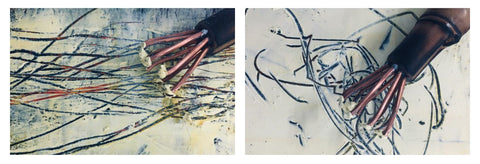
All too often we get used to creating marks that are predictable this tool refuses to allow that to happen. I had little control of the outcome which was exciting. The length of the handle encourages this, particularly if you hold it right at the end with your arm straight and let it wander over the paint!
The only bristle brush in this collection is the Coarse Stiff Horsehair Brush with Bamboo Handle, a tightly packed brush with a diameter of 2″. This is perfect for scrumbling and sweeping across a layer of paint, merging colors together whilst still leaving brush marks. I have used an old shaving brush in the past but this has a much tighter head and the long handle encourages confident expressive gestures.
|
|
Here I used the Coarse Stiff Horsehair Brush to blend colors using a circular motion. |
|
|
This close up shows the texture achieved by brushing an opaque layer of Titanium White and Yellow Ochre revealing dark colors underneath. |
I was concerned about how this brush would clean expecting it to hold lumps of paint, but although it stained slightly cleaning was straightforward. Unlike a standard bristle paintbrush, the density of the bristles means it actually holds very little paint.
Finally the beautiful Cold Wax Fiber “Flat” Brush. Holding the horizontal handle felt familiar, it is a similar action to holding a bowl scraper. The bamboo handle fills your hand, and like so many of Elizabeth’s brushes encourage confidence in its solidity. When held flat the marks lend themselves to sweeps and swirls but also angles as the delicate lines move across the surface. Held on edge it makes sharp singular lines. The flat row of fibers are held tight within the bamboo handle, but still have an element of flexibility, the cut corner giving an additional level of variety to the subsequent marks. I love the attention to detail on this tool; the copper ends serve to tighten the bamboo around the copper bristles but also provide a decorative touch.
 |
 |
On the left, I have dragged the brush over a transparent glaze of Green Gold The close-up an image in the right shows how the lines differ in width. |
 |
Dragging the tool back and forth over an opaque layer. |
Could I create my own tools to make similar marks? Probably, I have experimented in the past but anything I have made myself has never survived my process or been as inventive and sculptural as Elizabeth’s. I am a painter, not a toolmaker. Could I find other tools to create similar marks? Of course, but what has become apparent is these are tools made with love and care by an artist for an artist. This passing on of creativity is meaningful. It feels when I’m working that Elizabeth is with me and that brings a smile to my face. These tools are made to last a lifetime, to be used and treasured.
Sally Hirst Brush and Tools Demonstration
More About Sally Hirst
Sally Hirst’s work is about journeys; those that she takes and the journey that the artwork has been on in her studio. The textures, colors, and structures of each environment dictate the development of her artwork which whilst predominately abstract is based on fleeting images, imagination, and experiences. She invites you to pause a while, to take your own journey through the narratives she creates.
"I describe myself as an experimental printmaker. For me it means that I enjoy bending rules, inventing process and exploring layers of imagery. I am somewhat irreverent and always curious, always learning and always experimenting. I strive to create richly textured surfaces, to depict their essence through the abstraction of color, shapes, and lines, overlapping forms and textures"
Originally from South London, after completing her BA(hons) she studied Art Education at Cambridge University. After many years teaching Art and Design she is now a full-time artist and is currently studying for an MA in Fine Art. In 2017 and 2018 she took the intensive program offered by artist Nicholas Wilton, his approach enabled her to develop her individual way of working.
Sally runs workshops in painting and printmaking from her studio in the center of Norwich, UK, details can be found on her website www.sallyhirst.co.uk
-You can find her on Instagram @sallyhirstartist and Facebook @sallyhirstartworkshop



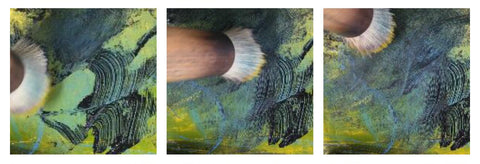
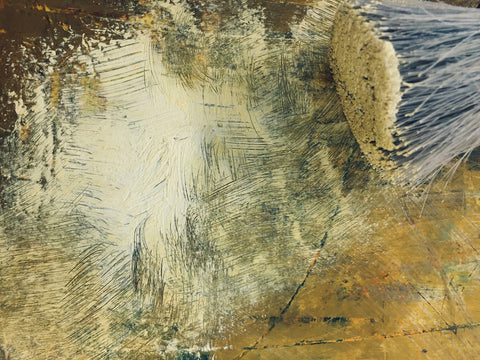









3 kommentarer
Hi, how do uou clean these tools? And i presume you can’t use the copper brush on the hot box :((? The rest of the tools would be fine?
Love these tools!
Thank you for inspiration on a day of “social distancing” that for me is open ended art time. The tools look amazing but I am inspired to create some of my own out of materials on hand, a good challenge on an day that otherwise could be a gloomy day of isolation.